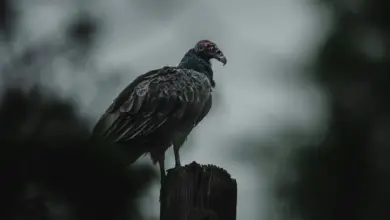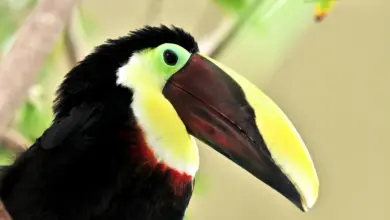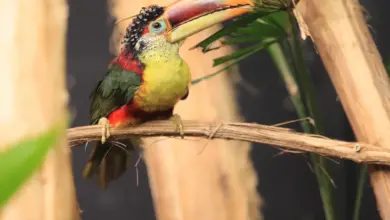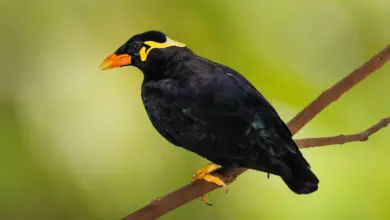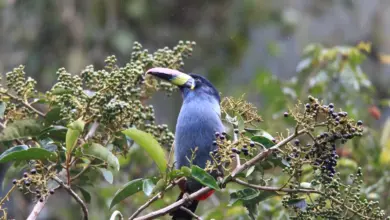The Maui Parrotbills Males have more intense yellow colouration, especially on the head. In the picture, the oversized head and massive beak of this finch-sized bird are visible to advantage.
As there are no woodpeckers in Hawai’i, the Maui Parrotbill has evolved to fill their ecological niche. It uses the hooked bill to probe old wood and boreholes of insects to find food.
These birds are highly threatened with extinction in the wild and are subject to an intense recovery effort that involves captive breeding at the Big Island KBCC and the Maui MBCC facilities. A strange problem encountered is that captive-bred birds of this species, especially females, imprint quickly on humans, losing their shyness, begging for food and even landing on hands or heads. This would be a huge disadvantage, were such individuals released into the wild.
The Maui Parrotbills (Pseudonestor xanthophrys) is a species of finch in the Hawaiian honeycreeper subfamily, Drepanidinae, that is endemic to Maui in Hawai’i. It can only be found in 50 square kilometres (19 sq mi) of mesic and wet forests at 1,200-2,150 metres (3,900-7,100 ft) on the windward slopes of Haleakala. The total population of this bird is estimated at 500, making it critically endangered.[2] Fossil evidence indicates that the bird could be at one time bee seen in dry forests and as far down as 200-300 metres (660-980 ft), as well as on the island of Moloka’i.
Description
The Maui parrotbill is one of the larger Hawaiian honeycreepers, measuring 14 centimetres (5.5 in)] and with a mass of 20-25 grams (0.71-0.88 oz).
The bird is yellow on the breast, cheeks, and belly, olive-green on the wings, crown, tail, and back, and has a bright yellow supercilium (line above each eye). The upper mandible of the bird’s beak is hooked and dark gray, while the lower mandible is chisel-like and pale ivory. Males are longer-winged, larger-billed, and heavier than females.
Juveniles are gray-green above and light gray ventrally.
Voice
Its call is a short “chip”, which is similar to the Maui Nui ‘Alauahio, it is spoken every three to five seconds.
It song is consisted of “cheer” notes that are slower and richer than the akepa.
It also has a sort of central song made up of the words “cheer-wee”.
Diet
The Maui parrotbill is an insectivore. It uses its large beak and powerful jaw muscles to remove bark and wood from small trees and shrubs such as akala (Rubus hawaiensis), kanawao (Broussaisia arguta), and ‘ohi’a lehua (Metrosideros polymorpha), eating the insects underneath. The Maui parrotbill will also bite open fruits in search of insects. It is fond of moth pupae and beetle larvae. Pairs of birds forage in a territory of 2.3 hectares (5.7 acres), which they must defend from competing parrotbills.
Breeding
The Maui parrotbill is a monogamous species and breeds between November and June. Females build a cup-shaped nest out of Usnea lichens and pūkiawe (Styphelia tameiameiae) twigs, placing it 12 metres (39 ft) above the forest floor. Pairs raise a single nestling per season. Incubation lasts 16 days and is performed by the female. Fledglings remain with their parents for five to eight months as they learn how to forage.
Habitat and distribution
The Maui Parrotbill is currently restricted to undisturbed wet forests dominated by ‘Ohi’a lehua (Metrosideros polymorpha) and small patches of ‘ohi’a-koa (Acacia koa) mesic forest. Its habitat contains a dense understory of small trees, shrubs, epiphytes, ferns, and sedges. The center of the Maui Parrotbill population is between Pu’u ‘Alaea, Kuhiwa Valley, Lake Waianapanapa, and upper Kipahulu Valley. This area is less than 2,020 hectares (5,000 acres) and at elevations of 1,310-2,070 metres (4,300-6,800 ft).
Conservation
The Maui parrotbill’s natural habitat is mesic and wet forests. The continued existence of this species is threatened by habitat destruction. Much of the land in the parrotbill’s historic range was changed for agricultural purposes, timber production and animal grazing. Introduced pests, such as mosquitoes, rats, and feral ungulates directly and indirectly affect the parrotbill’s survival. Mosquitoes spread avian malaria, which the parrotbill is susceptible to, rats prey upon the birds’ eggs and young, and feral pigs uproot the low-lying vegetation that the parrotbill forages in. Pigs additionally create wallows, which serve as breeding grounds for avian malaria-infected mosquitoes.
The Maui parrotbill was listed as an endangered species in 1967 under the Endangered Species Act. It is also part of the Maui-Molokai Bird Recovery Plan in 1984, which brought upon large-scale land management. Areas of East Maui were fenced and feral ungulates removed. The recovery plan also included a captive breeding program, which resulted in its first chick in 2003.
Copyright: Wikipedia. This article is licensed under the GNU Free Documentation License. It uses material from Wikipedia.org … Additional information and photos added by Avianweb.
Please Note: The articles or images on this page are the sole property of the authors or photographers. Please contact them directly with respect to any copyright or licensing questions. Thank you.
